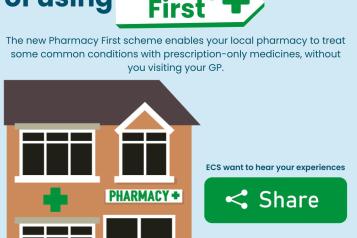Temporary closures add to crisis in community pharmacies - Healthwatch England
First geographical breakdown of pharmacy closures
Earlier this year, we submitted a Freedom of Information (FoI) request to Integrated Care Boards (ICBs) asking them about permanent and temporary pharmacy closures, following concerns raised by the public and local Healthwatch.
In 2022-23, there were 11,414 community pharmacies in England. However, our data obtained from all 42 ICBs revealed that 436 pharmacies closed permanently in England between 1 January and 31 December 2023. This means that, on average, over one pharmacy closed permanently every day.
During the same period, 13,863 temporary closures were reported across 41 ICBs, resulting in 46,823 hours lost and an average closure length of three hours and 40 minutes.
Most ICBs reported staff shortages, such as problems finding a locum, as the main cause of temporary closures.
Who's affected the most?
Our findings suggest that ICBs in rural areas recorded a higher level of temporary pharmacy closures compared to ICBs in predominantly urban areas.
Additionally, ICBs with a higher proportion of people over 60 years of age recorded a higher number of hours lost per pharmacy.
Regional disparities
The FoI data also revealed striking variations of temporary closures across ICBs:
- North East and North Cumbria ICB recorded the highest number of temporary closures, and hours lost, with 1,438 closures and 4,054 hours lost. When adjusting for the size of the ICB, Norfolk and Waveney ICB, reported the highest number of hours lost per pharmacy, 17.48 hours.
- Meanwhile, South East London ICB recorded the lowest number of temporary closures, 70, and North West London ICB the lowest number of hours lost (212).
- Kent and Medway ICB had the highest average closure length, five hours and 38 minutes, per pharmacy.
- The ICB with the lowest average closure length is North East London, with two hours and 22 minutes, per pharmacy.
See our map of pharmacy closures in England.
Temporary closures undermine Pharmacy First
The findings come after the General Pharmaceutical Council warned that 'the rate of closures is spiralling rapidly.' Their data showed that deprived areas had lost proportionally more pharmacies than less deprived areas.
Our research shows that temporary closures are adding to the mounting problems in the pharmacy sector, calling into doubt the success of the Pharmacy First programme. Launched in January, the programme allows people to get care for seven common conditions to relieve pressure on GP practices, but the ongoing closures are making it harder for people to access medications and care.
What we think
Our Chief Executive, Louise Ansari, said:
"Our research has shown that temporary pharmacy closures present a widespread challenge in England.
“This issue is having huge impacts on older people and is particularly acute in rural regions where people already have to travel further to visit their pharmacist.
“Staff shortages, the key driver of permanent and temporary closures, call into doubt the potential of Pharmacy First, meaning people can’t get the advice, care and medications they need and when they need them.
"We know that people's frustration often stems from not being informed about pharmacy closures in advance. Better signposting that pharmacies will be closed and setting out alternatives would go some way to improving patient experience.
"However, in the longer term, action must be taken to address staff shortages and unequal access. A national evaluation of pharmacy funding and the size, role-mix and distribution of the pharmacy workforce is necessary to improve planning of pharmacy services."
Debbie's story: "Many of the pharmacies in my area have closed down".
Debbie, 70, lives in Devon. Recent pharmacy closures have made getting medication and treatment more difficult for people in her community.
Debbie has several prescriptions, including medication to treat her thyroid and blood pressure. She has used the same pharmacy for many years and has been happy with the service, but that has changed.
"I was shocked by what I saw on my recent visit to pick up my medication. I had to queue out the front door and wait for at least 20 minutes to be attended to.
"Many of the pharmacies in my area have closed down. My local one is still open, but staff are overwhelmed with the demand. There's even a notice at the door that because of closures in the area, it will now take at least 10 days to prepare a repeat prescription."
We're calling for:
1. Patients to be better notified of pharmacy closures, and for pharmacy teams to be supported by improved contingency plans.
NHS England and Integrated Care Boards should support pharmacy teams to give appropriate notice and advice to the public wherever possible. This could be through the NHS App, NHS website, SMS platforms, and local GP and pharmacy websites – providing real time information on temporary closures.
ICBs should also analyse and publish monthly figures on the number of temporary closures to inform workforce planning, spot trends in postcode variations, and tackle persistent closures using agreed local hours plans. Data should be reported in a standardised form to help better inform national planning pharmacy services.
2. A national evaluation to consider issues facing pharmacy, including workforce, funding, data, and estates.
NHS England should commission a formal evaluation of the challenges facing the pharmacy sector. This evaluation should specifically examine pharmacy workforce planning to ensure that both the size and distribution of the pharmacy workforce is optimally geared towards ensuring equal access to services and expanding pharmacy’s care offer.


